i) Government Business Enterprise (GBE) means an entity that has all the following characteristics:
- Is an entity with the power to contract in its own name.
- Has been assigned the financial and operational authority to carry on a business.
- Sells goods and services, in the normal course of its business, to other entities at a profit or full cost recovery.
- Is not reliant on continuing government funding to be a going concern (other than purchases of outputs at arm's length); and
- Is controlled by a public sector entity
ii) Carrying amount
Is the amount at which an asset is recognized in the statement of financial position after deducting any accumulated depreciation and accumulated impairment losses thereon.
iii) Recoverable service amount
Is the higher of non-cash generating assets fair value less costs to sell and its value in use.
marto answered the question on February 14, 2019 at 05:15
-
a) In the context of International Accounting Standard (IAS) 21 (The Effects of Changes in Foreign Exchange Rates), explain two factors that should be considered...
(Solved)
a) In the context of International Accounting Standard (IAS) 21 (The Effects of Changes in Foreign Exchange Rates), explain two factors that should be considered in determining an entity's functional currency.
b) Ufanisi Ltd. is a Kenyan-based company that uses the Kenya Shilling (Ksh) as its presentation currency. On 1 January 2010, the company established a wholly owned
subsidiary, Ng'ambo Ltd., in a foreign country known as Ugenini, In addition to Ufanisi Ltd. making an equity investment in the subsidiary, a long term note payable to an Ugenini bank was negotiated to purchase property and equipment. The currency used in Ugenini is known as the Falanga (Fn). The subsidiary began operations with the following statement of financial position as at 1 January 2010:
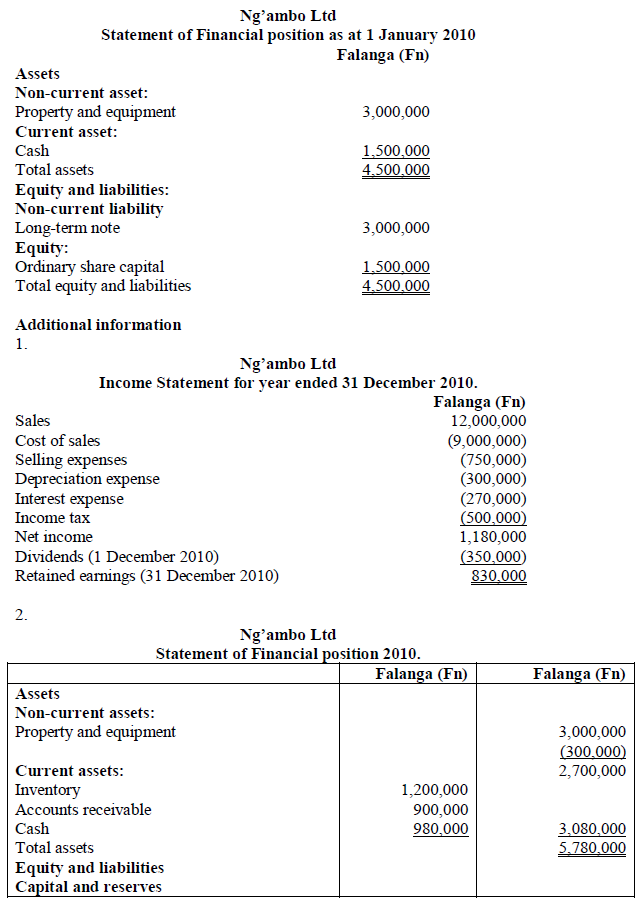
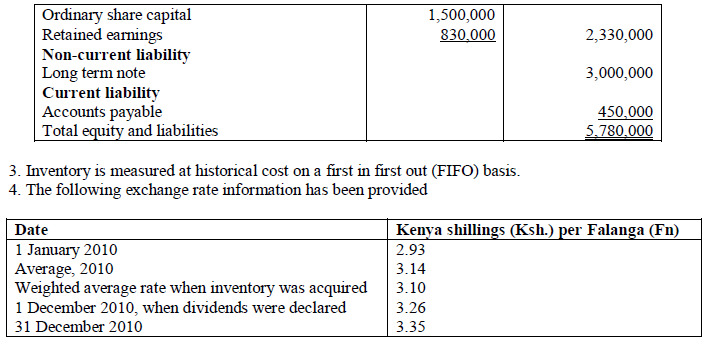
Required:
Translate the following financial statements of Ng'ambo Ltd. using the temporal method:
i) Income statement for the year ended 31 December 2010.
ii) Statement of financial position as at 31 December 2010.
Date posted:
February 13, 2019
.
Answers (1)
-
Halua Ltd., a local company, acquired 75% of the ordinary share capital of Sukari Ltd., a foreign company on 1 May 2008. Sukari Ltd.'s functional...
(Solved)
Halua Ltd., a local company, acquired 75% of the ordinary share capital of Sukari Ltd., a foreign company on 1 May 2008. Sukari Ltd.'s functional currency is the Rupia (Ra).
The following financial statements relate to the two companies for the year ended 30 April 2011:
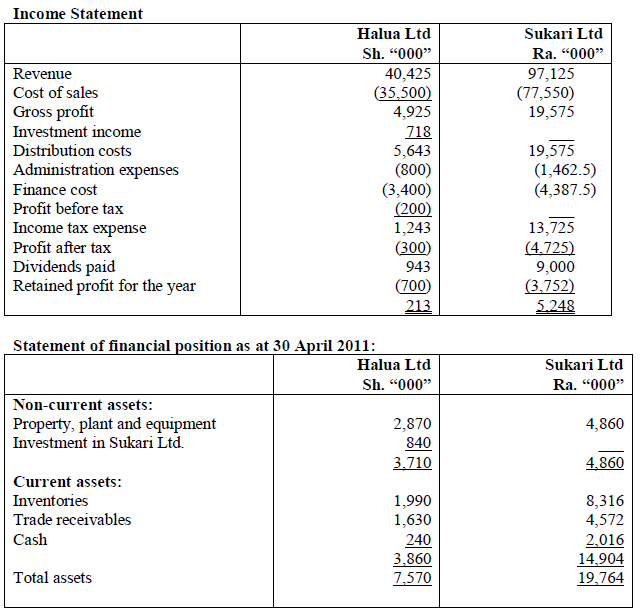
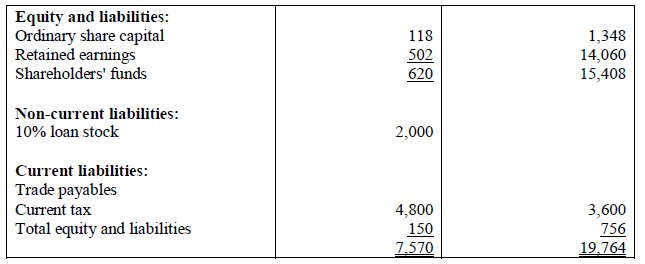
Additional information:
1. Halua Ltd. acquired the shares in Sukari Ltd. when the retained earnings in Sukari Ltd. were Ra 2,876,000.
2. During the year, Halua Ltd. sold goods worth Sh.5 million to Sukari Ltd. and reported a gross profit margin of 20% on selling price. Half of these goods were still in the inventory of Sukari Ltd. as at the year end.
3. Included in the receivables of Halua Ltd. is Sh.500,000 due from Sukari Ltd.
4. The translation differences in the consolidated financial statements at 30 April 2010 relating to the translation of Sukari Ltd. (excluding goodwill) were Sh.208,000. Retained earnings on the same date in Sukari Ltd.'s financial statements in the post-acquisition period as at 30 April 2010 amounted to Sh. 1,372,000.
5. The group uses the partial goodwill method and no impairment loss has been reported so far.
6. The following exchange rates are relevant.

Required:
a) Consolidated income statement for the year ended 30 April 2011.
b) Consolidated statement of changes in equity for the year ended 30 April 2011.
c) Consolidated statement of financial position as at 30 April 2011.
Date posted:
February 13, 2019
.
Answers (1)
-
The following financial statements relate to H Ltd. and its investment companies S Ltd., A Ltd. and J Ltd. for the year ended 30 April...
(Solved)
The following financial statements relate to H Ltd. and its investment companies S Ltd., A Ltd. and J Ltd. for the year ended 30 April 2012:
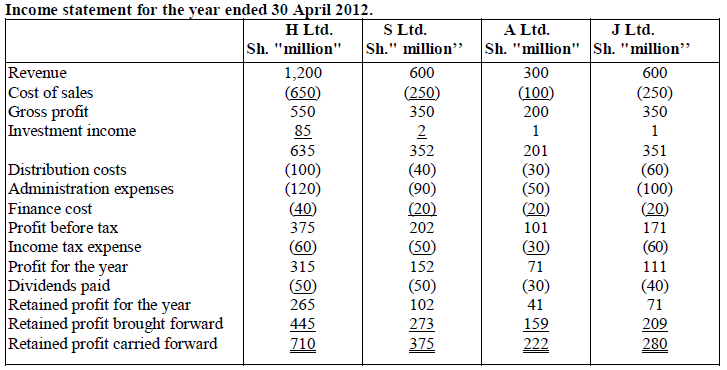
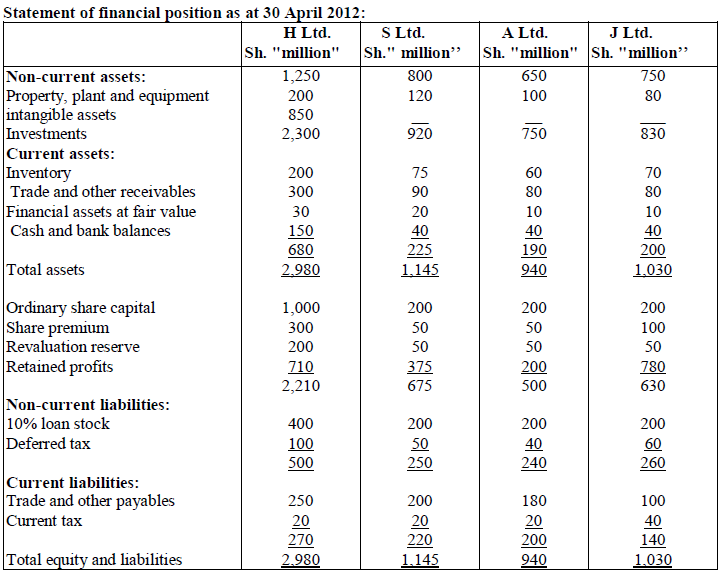
Additional information:
1. H Ltd, acquired the investments in the other companies as follows:

2. The fair value of the non-controlling interest in S Ltd. was Sh.75 million on 1 May 2008.
3. During the year ended 30 April 2012, II Ltd. sold goods lo S Ltd. and A Ltd. as follows:

4. On 1 May 2010, H Ltd. sold S Ltd. an item of plant for Sli.200 million reporting a 25% profit on the initial cost plant. The group charges depreciation at 20% per annum on cost on plant.
5. All the goodwills of the three companies in which H Ltd. has invested are estimated to be impaired by 25% in the year ended 30 April 2012. No impairment losses have been reported in the past.
6. Included in trade and other receivables and trade and other payables arc the following outstanding balances:
- Due from S Ltd. to II Ltd. - Sh.50 million
- Due from A Ltd. to II Ltd. - Sh.10 million
- Due from H Ltd. to J Ltd. - Sh.40 million
In the books of S Ltd. the amount due to H Ltd. was shown at Sh.40 million because S Ltd. had sent a cheque Sh.10 million but H Ltd. had not recorded the cheque. All the other balances were in agreement.
7. The group uses the full goodwill method and proportionate consolidation as per IAS 31 (Joint Ventures).
8. All dividends and interest had been paid by the end of the year.
Required:
a) Consolidated income statement for the year ended 30 April 2012.
b) Consolidated statement of financial position as at 30 April 2012.
Date posted:
February 13, 2019
.
Answers (1)
-
Explain the following terms as used in IAS 21 (The Effects of Changes in Foreign Exchange Rates):
i) Functional currency.
ii) Presentation currency.
(Solved)
Explain the following terms as used in IAS 21 (The Effects of Changes in Foreign Exchange Rates):
i) Functional currency.
ii) Presentation currency.
Date posted:
February 13, 2019
.
Answers (1)
-
a) In the context of IAS 21 (The Effects of Changes in Foreign Exchange Rates), critically appraise the concepts on which the closing rate and...
(Solved)
a) In the context of IAS 21 (The Effects of Changes in Foreign Exchange Rates), critically appraise the concepts on which the closing rate and the temporal methods are based indicating which factors should be taken into account when choosing between the two methods.
b) H Ltd., a publicly listed company, acquired the following investments:
- On 1 April 2012, the company purchased 24 million shares in S Ltd. This acquisition was made by way of an immediate share exchange of two shares in H Ltd. for every three shares in S Ltd. plus a cash payment of Sh. l per one share of S Ltd. This cash payment will be payable on 1 April 2015. The market price of H Ltd.'s shares on 1 April 2012 was Sh.2 each.
- On 1 October 2012, the company purchased 6 million shares in A Ltd. by paying an immediate Sh.2.50 in cash for each share.
The statements of financial position of H Ltd., S Ltd. and A Ltd. as at 31 March 2013 were as follows:
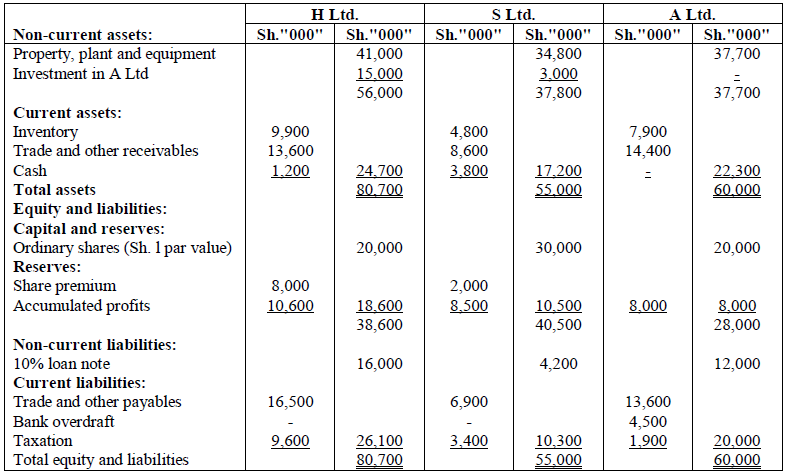
Additional information:
1. Below is a summary of the results of a fair value exercise S Ltd. carried out as at the date of acquisition:

The book values of the net assets of A Ltd as at the date of acquisition were considered to be a reasonable approximation to their fair values.
2. The profits of S Ltd. and A Ltd. for the year to 3 1 March 2013 were Sh.4.5 million and Sh.6 million respectively. No dividends have been paid by any of the companies during the year. Profits are deemed to accrue evenly throughout the year.
3. In January 2013, A Ltd. sold goods to H Ltd. at a selling price of Sh.4 million. These goods had cost A Ltd. Sh.2.4 million. H Ltd. had Sh.2.5 million (at cost to H Ltd.) of these goods still in inventory as at 31 March 2013.
4. Depreciation is charged on a straight-line basis. A full year's depreciation is charged in the year of acquisition.
5. Based on H Ltd.'s cost of capital which is 10% per annum. Sh. l receivable in three years' time can be taken to have a present value of Sh.0.75.
6. H Ltd. has not yet accounted for the acquisition of S Ltd. but has recorded the investment in A Ltd.
Required:
Consolidated statement of financial position as at 31 March 2013 in accordance with international financial reporting standards (IFRSs)
Date posted:
February 13, 2019
.
Answers (1)
-
P Ltd., a company incorporated in Kenya is listed in all the East African securities exchanges. P Ltd. uses the Kenya shilling (Ksh.) as the...
(Solved)
P Ltd., a company incorporated in Kenya is listed in all the East African securities exchanges. P Ltd. uses the Kenya shilling (Ksh.) as the reporting currency. On 1 April 2012, P Ltd. acquired a controlling interest in L Ltd.
On 1 October 2012, P Ltd. also acquired a controlling interest in U Ltd., a Ugandan. company that uses the Uganda shilling (Ush.) to report its financial results. The statements of comprehensive income for the three companies for the year ended 31 March 2013 are as set out below:
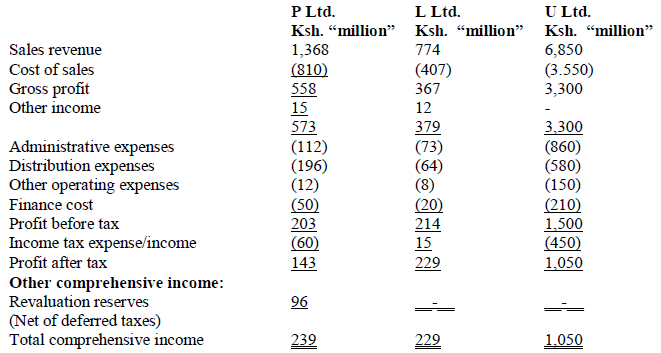
Additional information:
1. P Ltd. acquired 75% of L Ltd. through an exchange of 3.5 million equity shares of Ksh. 10 each.
The market value of the equity shares as at that date was Ksh.28 each. The fair value of the net assets of L Ltd, as at the date of acquisition was Ksh. 100 million.
2. P Ltd. acquired 60% of U Ltd. on 1 October 2012 for Ksh.47.5 million paid in cash. The fair value of the net assets of U Ltd. on that date amounted to Ush. 1,800 million. As at 31 March 2013, the exchange gain on retranslation of the net investment in U Ltd. was determined as Ksh.6.2 million.
3. During the year ended 31 March 2013, P Ltd. sold goods to L Ltd. for Ksh.28 million at cost plus 25%. 40% of these goods were still held within the group as at 31 March 2013.
4. P Ltd. operates some machines that pose an environmental hazard, for which they have an
irrevocable agreement to undertake decommissioning of the machines at the end of their useful life at a cost of Ksh. 18 million. The management estimates the remaining useful life of the machines to be 5 years and the relevant discount rate to be 12%. This item has not been accounted for.
5. The goodwill on acquisition of U Ltd. was considered to be impaired by 30% as at 31 March 2013.
6. On 1 January 2013, P Ltd. sold 1/3 (one third) of its investment in L Ltd. for a cash consideration of Ksh.62 million. The fair value of the net assets on that date was Ksh. 184 million. P Ltd. will account for the 50% interest in L Ltd. using the equity method in accordance with IFRS 11 (Joint Arrangements).
7. The following exchange rates are relevant:

8. Incomes and expenses of all the three companies were deemed to accrue evenly throughout the year.
Required:
(a) Goodwill on acquisition of L Ltd. and U Ltd.
(b) Consolidated statement of comprehensive income for P Ltd. for the year ended 31 March 2013. (NB: Round off the Ush. to the nearest Kenya shilling)
Date posted:
February 13, 2019
.
Answers (1)
-
With reference to IAS 31 (Interests in Joint Ventures), explain the three types of joint ventures.
(Solved)
With reference to IAS 31 (Interests in Joint Ventures), explain the three types of joint ventures.
Date posted:
February 13, 2019
.
Answers (1)
-
The following is an extract of the summarized financial statements of Ngoma Ltd, Kinanda Ltd. and Ngozi Ltd. for the year ended 30 September 2013:
(Solved)
The following is an extract of the summarized financial statements of Ngoma Ltd, Kinanda Ltd. and Ngozi Ltd. for the year ended 30 September 2013:

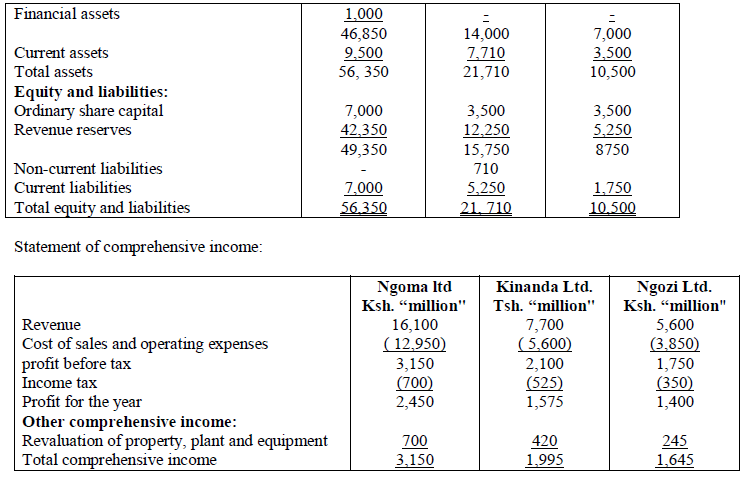
Additional information:
1. The functional currency of both Ngoma Ltd. and Ngozi Ltd. is the Kenya shilling (Ksh.) while the functional currency of Kin and a Ltd. is the Tanzania shilling (Tsh.).
2. Ngoma Ltd. acquired 80% of Kinanda Ltd. on 1 October 2011 for Ksh.18, 200 million when the revenue reserves of Kinanda Ltd. were Tsh.6, 300 million. The investment is held at cost in the individual financial statements of Ngoma Ltd.
3. Ngoma Ltd. acquired 40% of Ngozi Ltd. on 1 October 2008 for Ksh.3, 150 million when the revenue reserves of Ngozi Ltd. were Ksh.2, 450 million. The investment is held at cost in the individual financial statements of Ngoma Ltd.
4. Ngoma Ltd. advanced a 5 year loan of Ksh.1, 000 million to Kinanda Ltd. on 30 September 2012. This loan is included in the financial assets and non-current liabilities of Ngoma Ltd. and Kinanda Ltd. respectively. Kinanda Ltd. had recorded the loan at the exchange rate prevailing as at 30 September 2012.
5. An impairment test conducted on 30 September 2013 revealed that cumulative impairment losses in respect of the investment in Ngozi Ltd. were Ksh.1 ,000 million, of which Ksh.250 million related to the current financial year. No impairment losses were necessary in respect of the investment in Kinanda Ltd.
6. The group's policy is to value the non-controlling interest at fair value at the date of acquisition. The fair value of the non-controlling interest of Kinanda Ltd. at 1 October 2011 was Tsh.2, 100 million.
7. Ngoma Ltd. has a building which is located in the same country as Kinanda Ltd. The building was acquired on 30 September 2012 and is carried at a cost of Tsh.2.500 million. The property is depreciated over 10 years on a straight line basis. As at 30 September 2013, the property was revalued to Tsh.3, 500 million. Depreciation has been charged for the year but the revaluation has not been taken into account in the preparation of financial statements as at 30 September 2013.
8. Relevant exchange rates are as follows:

Required:
a) Consolidated statement of comprehensive income for the year ended 30 September 2013.
b) Consolidated statement of financial position as at 30 September 2013.
Date posted:
February 13, 2019
.
Answers (1)
-
H Limited, a quoted company at the securities exchange, acquired 80% of the equity shares of P Limited ten years ago.
On 1 April 2014, H...
(Solved)
H Limited, a quoted company at the securities exchange, acquired 80% of the equity shares of P Limited ten years ago.
On 1 April 2014, H Limited disposed of half of its investment in P Limited and acquired 80% of the equity shares of R Limited.
Below are the financial statements of the three companies for the year ended 30 September 2014.
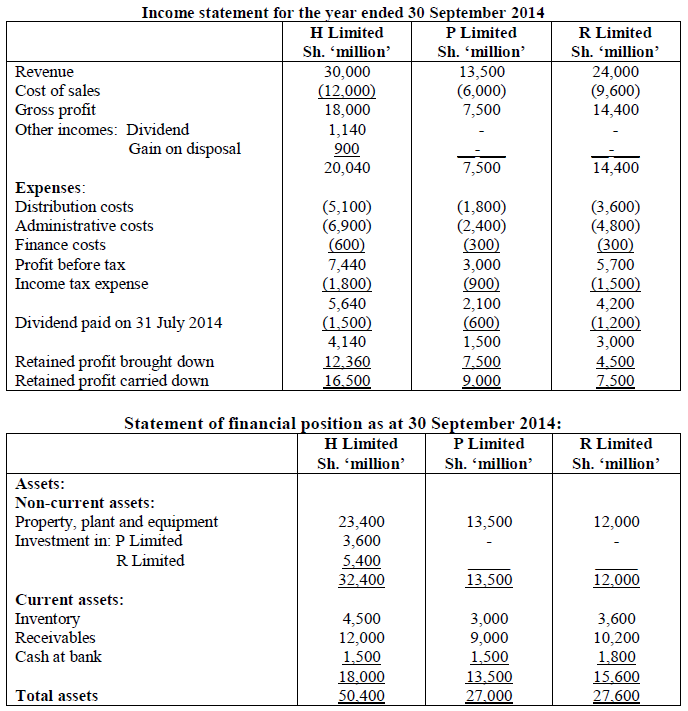
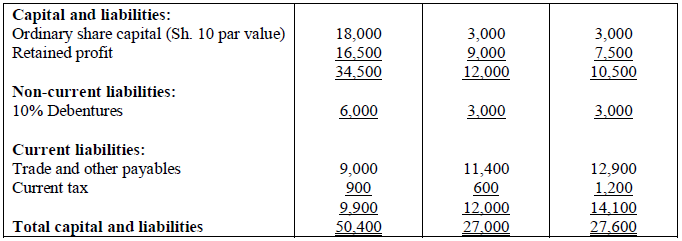
Additional information:
1. On 1 April 2014, H Limited disposed of half of its investment in P Limited for Sh.4, 500 million. This disposal has already been accounted for by H Limited but not by the group. The fair value of the remaining investment in P Limited was Sh.3, 900 million on the date of disposal.
2. H Limited had acquired its shareholding in P Limited for Sh. 7,200 million when the retained profit of P Limited amounted to Sh.4, 500 million.
There was no fair value adjustment at the time of this acquisition. Assume that the profits of P Limited accrued evenly during the year.
3. Intercompany receivables and payables were as follows as at 30 September 2014:

4. As at 1 October 2013 half of the goodwill of P Limited had been impaired. The goodwill of the companies were not impaired in the current year to 30 September 2014. The group uses the partial goodwill method when preparing the consolidated financial statements.
5. Between 1 April 2014 and 30 September 2014, H Limited sold to R Limited goods worth Sh.1, 200 million at a profit of Sh.300 million. 50% of the goods were still in the inventory of R Limited as at 30 September 2014.
Required:
a) Group income statement for the year ended 30 September 2014.
b) Group statement of financial position as at 30 September 2014.
Date posted:
February 13, 2019
.
Answers (1)
-
Accountancy bodies have a great deal of time and energy in developing codes of conduct. These codes supplement regulations imposed by government bodies.
Required:
a) Discuss the...
(Solved)
Accountancy bodies have a great deal of time and energy in developing codes of conduct. These codes supplement regulations imposed by government bodies.
Required:
a) Discuss the difficulties associated with regulating the activities of professionally-qualified accountants who are involved in the preparation and audit of financial statements.
b) Explain why government bodies might wish to regulate the financial reporting process despite the fact that professional bodies already regulate the activities of the members
Date posted:
February 13, 2019
.
Answers (1)
-
Briefly explain any two challenges faced by the accounting profession and reporting entities with regard to the application of current international accounting standards on financial...
(Solved)
Briefly explain any two challenges faced by the accounting profession and reporting entities with regard to the application of current international accounting standards on financial instruments.
Date posted:
February 13, 2019
.
Answers (1)
-
Explain the term 'accounting theory' and indicate why it is important in the practice of accounting.
(Solved)
Explain the term 'accounting theory' and indicate why it is important in the practice of accounting.
Date posted:
February 13, 2019
.
Answers (1)
-
Briefly comment on the emergence of social environmental accounting and reporting in the last few years
(Solved)
Briefly comment on the emergence of social environmental accounting and reporting in the last few years
Date posted:
February 13, 2019
.
Answers (1)
-
Citing reasons, explain why it is important for a reporting entity to provide a social and environmental report in the annual financial statements.
(Solved)
Citing reasons, explain why it is important for a reporting entity to provide a social and environmental report in the annual financial statements.
Date posted:
February 13, 2019
.
Answers (1)
-
Many corporate boards are now agreed on the need to take responsibility for any potential or actual social impact caused by their companies’ activities. This...
(Solved)
Many corporate boards are now agreed on the need to take responsibility for any potential or actual social impact caused by their companies’ activities. This is done through a social responsibility report.
Required:
(a) Write short notes on five issues/stakeholders that may be addressed by a company’s social responsibility report.
(b) Explain five benefits that would accrue to a company from the reporting of the company’s social responsibility activities.
(c) Comparing conventional financial accounting reporting with social responsibility reporting, list and explain five challenges peculiar to social responsibility accounting
Date posted:
February 13, 2019
.
Answers (1)
-
The following information was extracted from the books of Engwen Ltd. As at 30 June 2008
(Solved)
The following information was extracted from the books of Engwen Ltd. As at 30 June 2008
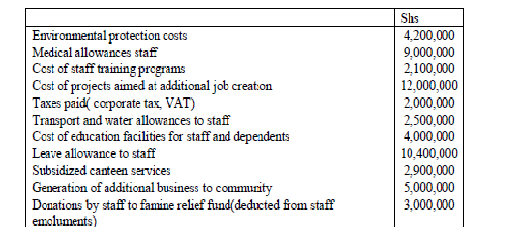
The company’s activities had a negative impact on the cost of living of the community, which increased by shs.3, 500,000 during the year ended 30 June 2008.
Required:
A statement of net social benefits to staff and community for the year ended 30 June 2008.
Date posted:
February 13, 2019
.
Answers (1)
-
The International Accounting Standards Board (IASB) is currently working with other accounting standards setting bodies in the world to have a global application of International...
(Solved)
The International Accounting Standards Board (IASB) is currently working with other accounting standards setting bodies in the world to have a global application of International Financial Reporting Standards. An important point of focus is conceptual framework.
Required:
Explain the importance of a conceptual framework and the key issues that such a framework should address.
Date posted:
February 13, 2019
.
Answers (1)
-
Amos Tiriki Headline Electronics (ATHE) develops and manufactures innovative computer peripherals. It sells its products to variety of vendors in its home country and the...
(Solved)
Amos Tiriki Headline Electronics (ATHE) develops and manufactures innovative computer peripherals. It sells its products to variety of vendors in its home country and the vendors sell in turn to corporate and individual customers.
The company is in the process of finalizing its draft financial statements for the year ended 31 December 2007. The finance director is locked in a major debate with a partner in charge of external audit. During the year the company spent a material amount on attending a major tradefair in Cheptulu Town. This was the first time that the company had attended the event. The trade fair is the biggest opportunity for the companies such as ATHE to talk to potential customers from all over the world. All major multinational electronics companies are represented at this annual event. The fair lasted for five days in June 2007. It is now January 2008 and not a single order has been generated from new customers who might have seen ATHE’s presentation at the trade fair.
The partner in charge of the external audit feels very strongly that the cost of attending the fair should be written off as an expense. ATHE’s finance director feels equally strongly that the cost should be capitalized as an asset. He argues that the contacts made at the trade fair are likely to take years to generate new business and that the investment in attending should be carried forward until those orders start to come in. He argues further that the cost should be capitalized on the grounds that they meet the definition of an asset, as laid down by the IASB’s Frame work for the preparation and presentation of financial statements (Framework)
Required:
a) Discuss the finance director assertion that the money spent on attending the fair should be treated as an asset.
b) Explain the importance of the Framework to the reporting of corporate performance and whether it takes into account the business and legal constraints placed.
c) Discuss the assertion that the external auditor might be the primary beneficiary of having a clear and unequivocal Framework that sets out the basis for financial reporting
Date posted:
February 13, 2019
.
Answers (1)
-
Evaluate the main steps followed in the development and issue of international financial reporting standards (IFRS)
(Solved)
Evaluate the main steps followed in the development and issue of international financial reporting standards (IFRS)
Date posted:
February 13, 2019
.
Answers (1)
-
In the context of IFRS 4(Insurance Contracts), identify four items that are excluded from requirements of this standard.
(Solved)
In the context of IFRS 4(Insurance Contracts), identify four items that are excluded from requirements of this standard.
Date posted:
February 13, 2019
.
Answers (1)